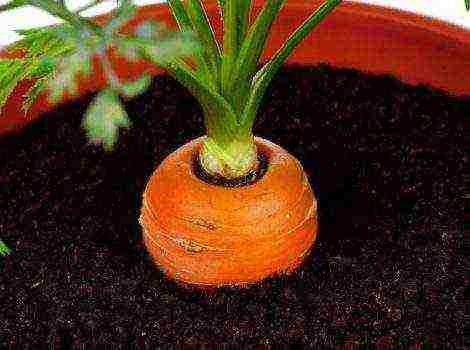Content
There are more than enough mushroom lovers in our country! Only for a hike into the forest for a "quiet hunt" you need the accompanying weather and certain climatic conditions. Not everyone will think about growing mushrooms at home, and even almost on an industrial scale. Most consider this to be fantastic. However, everything is real. And we will tell you how to grow mushrooms in a greenhouse or at home.
What mushrooms can be grown at home
The very idea of growing mushrooms at home poses a choice of a specific species. All varieties suitable for home breeding do not need special material costs or additional efforts. The only exceptions are champignons, but an experienced gardener will cope with this problem. The choice must be made, first of all, based on the desired profit. All varieties of mushrooms suitable for growing at home can be classified into two main types:
- woody;
- soil.
The former include the well-known shiitake mushrooms, oyster mushrooms, and winter mushrooms. But to the second - no less popular mushrooms and ringlets. Even with small areas, the harvest can be excellent. That is why these varieties are recommended for growing on an industrial scale.
 Growing oyster mushrooms at home on the balcony
Growing oyster mushrooms at home on the balcony
Growing technology for beginners
The bulk of the time it takes to grow mushrooms is spent creating mycelium. However, the advice of experienced mushroom growers suggests that it is better to grow this material on your own. After all, even the best and trusted suppliers fail from time to time. Mycelium can be grown in two ways:
- in the grain substrate;
- on wooden sticks.
The choice depends on what kind of mushrooms you plan to grow.
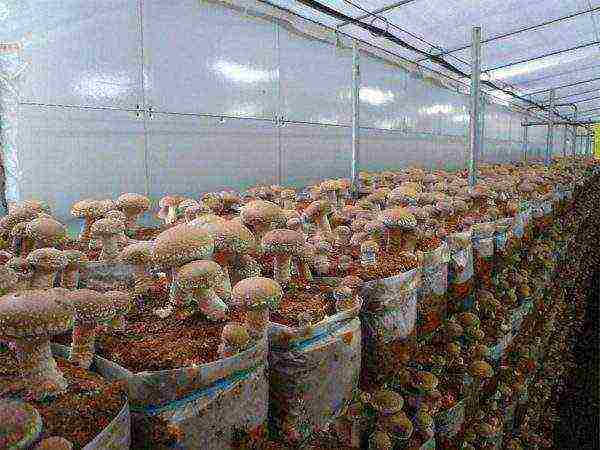 Growing mushrooms on a nutritious substrate
Growing mushrooms on a nutritious substrate
Breeding mycelium
The mycelium is grown in a specific substrate. It is recommended to make sure that its chemical and mineral composition is as similar as possible to that in which mushrooms grow naturally. The composition of this medium must be selected again, depending on the type of mushrooms being grown.
For example, shiitake mushrooms feel more comfortable in wood, mushrooms - in compost, but oyster mushrooms prefer straw. With proper care, chopped straw and sawdust can yield any of these types of mushrooms. However, the substrate must be of high quality. This is ensured by its dryness, absence of mold, as well as unpleasant odors and foreign impurities.
Wheat straw is best suited for growing mushrooms. You can also use rye or barley. Oyster mushrooms are allowed to be propagated in sunflower husks. However, only fresh material should be used, since pathogenic bacteria can grow excellently in old ones.
The mycelium is the backbone that contains a large number of germinated fungal spores. As soon as this base is placed in the substrate, the process of active growth begins. Initially, only the appearance of thin filaments can be observed, which eventually turn into edible mushrooms.
 Mushroom mycelium
Mushroom mycelium
It is worth purchasing high-quality planting material only in specialized stores. Priority should be given to wood containing viable fungal spores.They will be more resistant to disease. Not planted from grain mycelium. You can also buy common mushroom spores. Only in this case it will take more time and effort to grow your crop. The procedure will resemble the cultivation of any crop from seed. It is better for beginners to avoid this method.
To obtain the maximum yield, it is necessary that the mycelium spreads as thoroughly as possible in the compost. To do this, you need to keep the planting warm. They can be heated using a special electric pillow. Heat is needed only during the incubation period. Once the mushrooms are in the growing phase, it is best to keep them cool. A glazed and insulated balcony is well suited for this.
When growing mushrooms in residential premises, the maturation phase must be avoided. Otherwise, the spores released into the air can provoke allergic reactions and even asthma.
As a rule, seedlings appear in the third week after planting the mycelium. Readiness for harvesting is determined by the hat. You need to cut off ready-made mushrooms only with a knife, so as not to injure those that are still in the soil and are just preparing to give a crop. The ready-made collection can be used both immediately and after preliminary freezing.
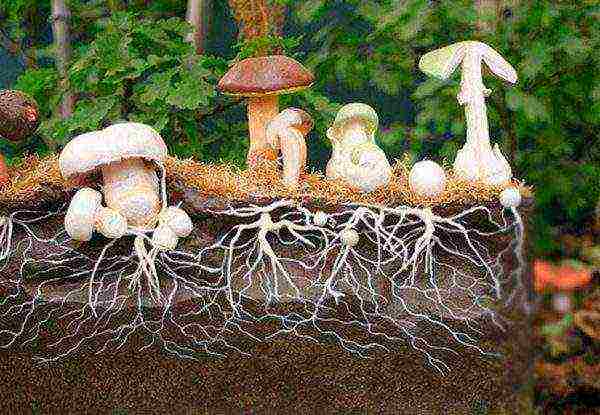 Sectional diagram of mushroom growth from mycelium
Sectional diagram of mushroom growth from mycelium
Other ways to grow mushrooms at home
In addition to the main ones, there are also additional ways of growing mushrooms. True, they do not bring such a large-scale result and are used mainly by children as experiments. For example, some types of mushrooms can be grown on logs. For this logs up to half a meter long are cut from hardwood. This must be done at least 2 weeks before settling with mycelium.
In the resulting workpiece, holes are made in a checkerboard pattern at a distance of 10 cm. After that, it is necessary to seal the sticks with mycelium. A hammer can be used for this procedure.
Before starting work, you must disinfect your hands and make sure that there is no debris in the holes.
The logs filled with mycelium are placed in the basement and wait until it fills the entire space. The procedure is lengthy and can take up to 1 year. Temperature and humidity are considered key conditions.
A known method of growing mushrooms on coffee grounds. It contains many trace elements:
- manganese;
- potassium;
- magnesium;
- nitrogen.
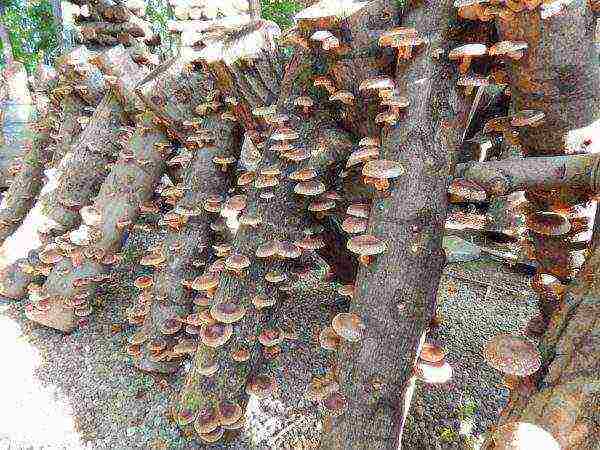 Growing mushrooms on stumps
Growing mushrooms on stumps
This environment is ideal for oyster mushrooms. In addition, the coffee grounds do not need to be sterilized again. The disadvantage of this method is that it is very difficult to get a large amount of freshly drunk cake at home. We'll have to ask him at the nearest cafe. The growing container can be regular freezer bags or ice cream containers.
The mycelium must be mixed with the cake, and then the container must be tightly closed. It can be stored under the sink. Germination time will be about 1 month. Once the surface is white, cut a small hole in the top of the bag. Through it, it is necessary to spray with water 2 times a day. After a week, you can see how small mushrooms begin to grow.
Growing porcini mushrooms and other species at home for beginners is a very exciting and useful activity. The needs of your family can be fully satisfied, even without special skills and large areas. The main thing is patience and a desire to see the result. After all, you can grow them all year round!
Home growing of mushrooms is becoming more and more popular every year. Unfortunately, not all varieties of mushrooms can be bred in this way, some of them are too capricious to the surrounding conditions, others require serious financial investments. Based on this, before you start mushroom growing on your own, you need to find out what mushrooms are grown at home.Most often these are the following types:
- Champignons (all varieties), volvariella, ringlet, raincoat, dung beetle. These are soil fungi, usually they grow in fields or meadows in the humus layer of the soil.
- Porcini mushrooms, chanterelles, boletus, boletus, truffles, morels, mushrooms. These are mycorrhizal fungi that form a symbiosis with the roots of only certain trees. They are artificially grown from purchased mycelium (mycelium is sprouted mushroom spores that are placed in a substrate), but it is rather difficult to breed these types at home.
- Oyster mushroom (all types - common, royal, pink, lemon), honey mushrooms (winter, summer, poplar, marble), gericium, tinder fungus, shiitake. These types of fungi grow on the wood of dead trees or plant debris containing cellulose.
The most unpretentious of all and the easiest to grow at home are oyster mushrooms, shiitake, winter mushrooms, mushrooms and ringlet.
All of these species have certain requirements for the conditions of detention. It remains only to figure out which ones.
 Oyster mushroom is in the first place in terms of prevalence and ease of cultivation. For novice mushroom growers, experienced entrepreneurs who have been engaged in mushroom growing for a long time offer to start growing mushrooms from it. When artificially growing oyster mushrooms, costs are required less than for all other mushrooms. Oyster mushroom is distinguished by unpretentiousness, excellent taste, early maturity, excellent yield, high resistance to viruses and bacteria, as well as rather long shelf life. Oyster mushrooms are grown in plastic bags (with a substrate, mushroom mycelium and bio-additives), on hemp, sawdust of various trees, straw, husk, corn stalks. Mushrooms grow well in rooms with a humidity of 80-85% and at fairly wide temperature ranges (from 10 to 30C, average values 16-20C). The first harvest of mushrooms can be cut after 30 days (in winter after 45). From one mushroom block at a time, it turns out to remove an average of 2.5-3 kg of the crop. At the same time, serve 100 blocks on an area with an area of 30 sq. m. without any problems even one person can. Mushrooms produce crops for 5 years.
Oyster mushroom is in the first place in terms of prevalence and ease of cultivation. For novice mushroom growers, experienced entrepreneurs who have been engaged in mushroom growing for a long time offer to start growing mushrooms from it. When artificially growing oyster mushrooms, costs are required less than for all other mushrooms. Oyster mushroom is distinguished by unpretentiousness, excellent taste, early maturity, excellent yield, high resistance to viruses and bacteria, as well as rather long shelf life. Oyster mushrooms are grown in plastic bags (with a substrate, mushroom mycelium and bio-additives), on hemp, sawdust of various trees, straw, husk, corn stalks. Mushrooms grow well in rooms with a humidity of 80-85% and at fairly wide temperature ranges (from 10 to 30C, average values 16-20C). The first harvest of mushrooms can be cut after 30 days (in winter after 45). From one mushroom block at a time, it turns out to remove an average of 2.5-3 kg of the crop. At the same time, serve 100 blocks on an area with an area of 30 sq. m. without any problems even one person can. Mushrooms produce crops for 5 years.- Champignons occupy the next place in terms of the popularity of cultivation, both in an industrial economy and at home. They are much more demanding on the conditions of detention. And the technology of growing them is more expensive than breeding oyster mushrooms. Mushrooms are grown in bags or boxes with soil, in which the mycelium is laid. Champignons grow well in dark, cool rooms (12-18C, maximum value no more than 28C) with a humidity of 65-85%. The first harvest of mushrooms is ready for harvest in 45-50 days, and the next ones can be harvested within 3 months.
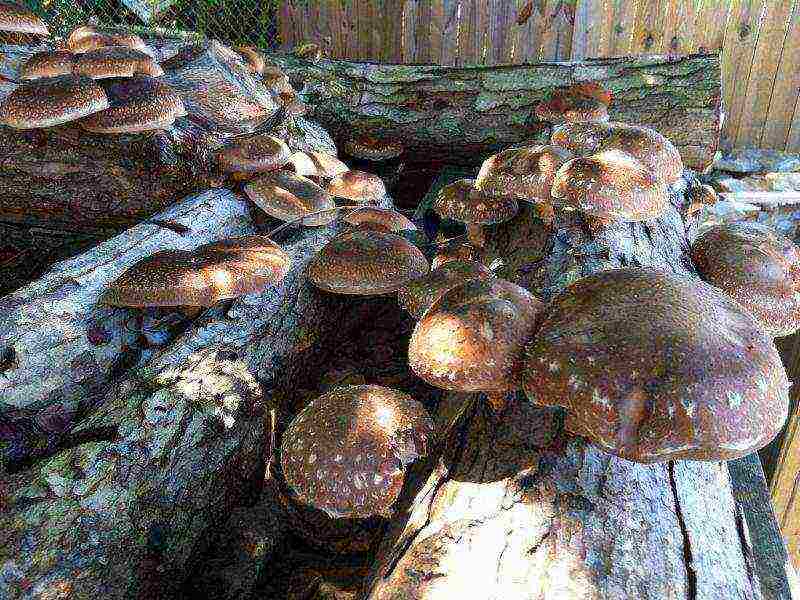 Shiitake - not only tasty, but also a very healing mushroom (successfully used in the treatment of cancer). Until a certain point, it was grown only in Asian countries. Shiitake is one of the most expensive mushrooms (the price is about $ 50 per 1 kg). Grows well at an average temperature of 12C. It is grown on sections of wood and on various substrates. It is important to know that in order to get a harvest of really tasty and healthy shiitake, the mycelium for breeding must be purchased from Japan or China, but not European, because it is spoiled by selection. The first harvest usually begins only in the next year and will last up to three years.
Shiitake - not only tasty, but also a very healing mushroom (successfully used in the treatment of cancer). Until a certain point, it was grown only in Asian countries. Shiitake is one of the most expensive mushrooms (the price is about $ 50 per 1 kg). Grows well at an average temperature of 12C. It is grown on sections of wood and on various substrates. It is important to know that in order to get a harvest of really tasty and healthy shiitake, the mycelium for breeding must be purchased from Japan or China, but not European, because it is spoiled by selection. The first harvest usually begins only in the next year and will last up to three years.- Winter honey - mushroom quite resistant to cold, grows well at ambient temperatures of 1-2 ° C. This mushroom has a pleasant taste and good nutritional value. It perfectly adapts to parasitizing on trees with living wood, and for this reason it should not be grown in backyard gardens or vegetable gardens, it is recommended to grow only on substrates and log cabins indoors.
- Koltsevik - not very well-known mushroom. Its cultivation began relatively recently, only about 25 years ago. This mushroom outwardly resembles a boletus, and in taste competes with champignons. It is grown on a personal plot directly on open ground beds or in plastic bags and boxes.
By becoming familiar with which mushrooms are grown at home, choosing a certain type for yourself and following the rules of caring for them, you will receive a constant tasty source of nutrients.
3 parts: Basic growing method Growing mushrooms on coffee grounds Alternative growing methods
Growing mushrooms at home is a task that anyone interested in growing food for their own consumption should tackle at least once. Mushrooms are a beneficial addition to any diet because they are low in calories and fat, but high in fiber and potassium. Plus, they're easy to grow at home. Mushrooms are best grown in an area where temperature and conditions are easy to manage. Knowing how to grow mushrooms at home will help you carefully manage your growing conditions.
Part 1 The main method of growing
-
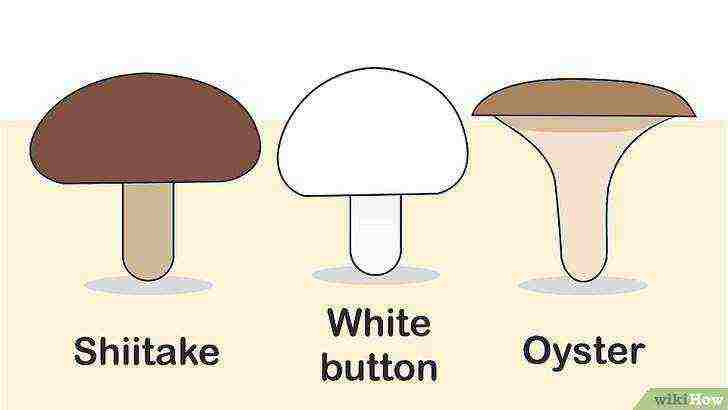 Choose the type of mushroom to grow.
Choose the type of mushroom to grow.
There are 3 types of mushrooms that are easiest to grow at home: oyster mushrooms, champignons and shitaki. The cultivation method for each type of mushroom is similar, but the ideal growing medium is different.
- Oyster mushrooms are best grown in straw. Shiitaks grow better on deciduous sawdust, and mushrooms grow on compost manure. These different nutrient media reflect the different nutritional needs of each species. However, each of the 3 species is easy enough to grow in sawdust or straw.
- The choice of mushrooms for growing is a matter of taste. You need to grow the mushroom that you want to eat.
-
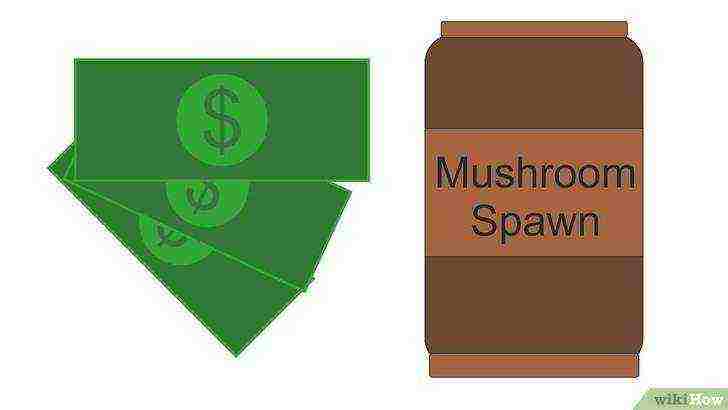 Buy mycelium.
Buy mycelium.
Myceliums are sawdust permeated with fungal mycelium - in fact, the root structure of the fungus. They are used as seedlings of plants to promote growth.
- You can buy high quality mycelium from your online store, gardening store, or other specialty organic store.
- Buy mycelium, not spores. Some stores also sell spores that look more like plant seeds (rather than seedlings). Growing mushrooms from spores takes more time and practice and is best suited to a seasoned mushroom grower.
- Sterilize the culture medium.
If you grow mushrooms in straw or sawdust, you must sterilize this substrate before sowing the mycelium. This is done in order to kill any microorganisms that might compete with the mycelium.
- To sterilize the medium, place it in a heat-resistant bowl and add enough water to make the straw or sawdust damp. Place the bowl in the microwave and heat it on high power for two minutes or until the water has boiled away.
- This kills all microorganisms, making it a safe breeding ground for mycelium to be accepted. You may have to work in batches to sterilize all straw or sawdust completely.
- Heat the substrate to spread the mycelium in it.
The mycelium must be thoroughly spread in a nutrient medium for the mushrooms to grow. Warm temperatures stimulate growth.
- After choosing a substrate for your mushroom species, place a few handfuls of it in a baking sheet. A shallow baking sheet with a large surface area is ideal for growing mushrooms.
- Stir the mycelium into the substrate with a sterilized spoon or similar. Place the baking sheet on an electric pillow set at 21 ° C. This is the ideal temperature to stimulate growth.
- Leave the unit in a dark environment such as a closet for three weeks. This will allow the mycelium to spread in the nutrient medium.
- Place the substrate in a suitable location.
After three weeks, place the substrate in a dark and cool place (about 13 ° C).As a rule, a basement is suitable for this, but in winter, a closet or drawer in an unheated room will do.
- If you notice green or brown spots on the substrate (like moldy bread), remove the spots and discard.
- Pour a handful of soil onto the substrate and sprinkle everything with enough water to thoroughly wet. You can cover the baking sheet with a damp towel to prevent moisture loss.
- You can place a low heat lamp next to the baking sheet. It will replace the sun, and the mushrooms will begin to reach for it and grow upward, which will further facilitate their collection.
- Keep the mixture moist and cool while the mushrooms are growing. Check it periodically and spray with water as needed.
- Mushrooms prefer coolness. The most important thing is not to let them overheat. At temperatures below 21 ° C, the mushrooms should grow excellently.
- Harvest when the mushrooms are fully grown.
After about three weeks, you will have small mushrooms. Maintain moisture, coolness, and darkening to encourage their growth.
- When the mushroom caps are completely detached from their legs, they can be collected. You can pick mushrooms with your fingers, but you risk damaging newly developing mushrooms below the surface. Better to use a sharp knife to cut the mushrooms at the base of the stem.
- Rinse the mushrooms before cooking. The harvested mushrooms can be stored in a paper bag in the refrigerator for up to seven days.
Part 2 Growing mushrooms on coffee grounds
-
 Take out the coffee grounds.
Take out the coffee grounds.
Growing mushrooms from coffee grounds is an interesting project that reuses coffee grounds that would otherwise go to waste. Coffee grounds are an excellent breeding ground for mushrooms (in particular oyster mushrooms), as they are already sterilized during the coffee brewing process and are full of nutrients.
- For 500 g of mycelium, you will need 2.5 kg of fresh coffee grounds. The best way to get that much fresh coffee grounds (brewed on the same day) is in a café and kindly ask. Most likely, they will gladly give it to you.
-
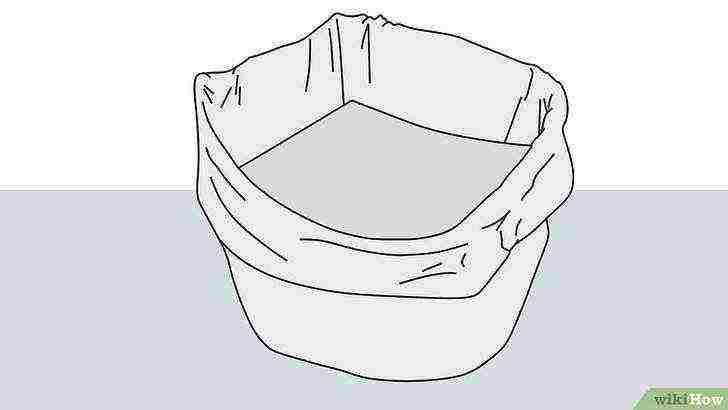
Find a container for mushrooms. It is best to use a special filter bag that can be purchased with the myceliums. If not, you can use a large airtight freezer bag, a cleaned milk carton, or an ice cream carton with four holes punctured in the sides.
-
Transfer the mycelium to a container. Wash your hands thoroughly with antibacterial soap, then stir the mycelium into the coffee grounds, crushing it with your hands to distribute it evenly. Place the planted coffee grounds in a plastic bag or container and seal tightly.
- Place the mycelium in a suitable environment.
Place the bag or container in a warm, dark place between 18 and 25 ° C, such as under a sink. Leave it on for about three to four weeks until the contents are completely white due to the mycelium settling in the coffee grounds.
- If green or brown spots appear on the substrate, cut them out to avoid poisoning later.
-
Move the mushrooms. When the contents of the bag or container become completely white, move it to a bright place (but not in direct sunlight) and cut a 5x5 cm hole on top.Moist the contents of the container by watering it twice a day to prevent drying out - the mushrooms will not grow too dry conditions.
- Harvest the mushrooms.
Over the next five to seven days, the tiny mushrooms will start to sprout. Keep hydrating them with water and they will double in size daily. When the mushroom caps begin to curl slightly upward, they can be collected.
- When the mushrooms stop sprouting, plant coffee grounds in your garden, cover with bark mulch or compost, and new mushrooms may sprout depending on the weather.
Part 3 Alternative cultivation methods
-
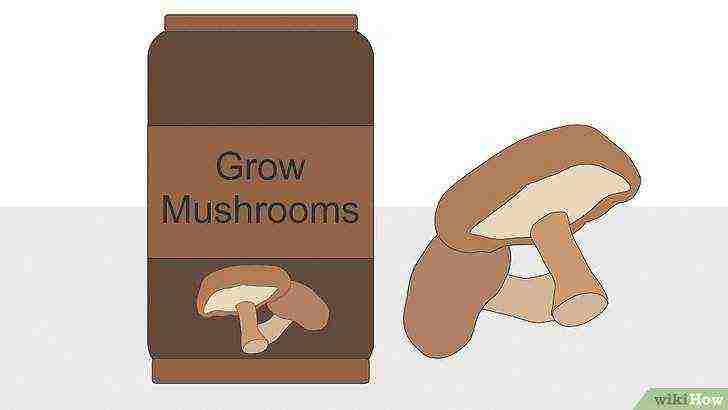 Grow mushrooms from the kit.
Grow mushrooms from the kit.
Growing mushrooms from a ready-made kit is a fun and easy way for beginners. Such kits usually consist of plastic bags filled with sterilized and seeded straw or soil. All you need to do is store the bag in the right conditions for seven to ten days until you have your homegrown mushrooms.
- The sets usually contain the most common varieties of mushrooms such as champignons, shiitake mushrooms and oyster mushrooms.
- To start growing, simply open the bag and place it in a well-lit area out of direct sunlight, such as a shaded window sill. The kit can be kept at room temperature, but it needs to be moistened daily with water to maintain a high humidity. Some kits have plastic tarps to cover the bag and keep the humidity level.
- Mushrooms will begin to germinate after seven to ten days, but within three months they may suddenly start growing two or three more times.
- After you have collected all the mushrooms, you can bury the substrate with mycelium in the garden, sprinkle with bark mulch, or in a compost heap. Then, depending on the weather conditions, the mushrooms will start growing in this place.
- Grow mushrooms on a log.
Another interesting way to grow certain types of mushrooms - such as reishi, ram mushroom, shiitake, oyster mushrooms - on a log. Birch plugs, completely sown with mycelium, are stuck into a piece of log. Stoppers can be obtained online and from specialized mushroom spore suppliers.
- The first thing to do is find a suitable log for growing mushrooms. You will need non-scented deciduous logs such as maple, poplar, oak, or elm. They should be 90-120 cm long and no more than 35 cm in diameter. Cut them out at least two weeks before clogging in order to destroy the natural antifungal properties of the tree.
- To "populate" a piece of log 90-120 centimeters long, you will need about 50 plugs. Use a 5/16 ″ drill to insert the plugs. Make holes 5 cm deep throughout the log in a staggered manner. The distance between them should be about 10 cm. Insert birch plugs into the holes and hammer them in to seal them completely.
- If you plan to leave the log outdoors, you will need to seal the holes with cheese wax or beeswax to protect the plugs from insects and harsh weather. If you will be storing the log at home, in a garage or basement, this is not necessary.
- Over time, the mushroom mycelium will spread on the birch plugs throughout the log until the entire piece of wood is inhabited. After complete settlement, the mushrooms will begin to sprout from the cracks in the log. This usually takes 9-12 months, but depending on the temperature and humidity, the mushrooms should appear again from year to year.
Tips
- For more information on growing mushrooms at home and outdoors, read this article.
What do you need
- Mycelium
- Straw, sawdust or manure
- Baking tray
- Heating pad
- Potting soil
- Sprinkler
- Water
- Towel
Article Information
This page has been viewed 85,433 times.
Was this helpful?
Growing mushrooms in the countryside or in your garden is simple and profitable. Having created with his own hands a suitable soil for the growth of the mushroom, the farmer will be able to sell and eat honey mushrooms, porcini mushrooms, chanterelles, shiitake and oyster mushrooms at a high price, without significant financial costs.
The content of the article:
- Growing champignons
- Growing honey agarics at home
- Growing oyster mushrooms at home
- Cultivation of porcini mushrooms in a personal plot
- Growing chanterelles at home
- Growing shiitake mushrooms at home
- And in conclusion
Growing champignons
Today, mushroom cultivation has become a fairly profitable and widespread agricultural activity. Growing champignons at home is certainly not an easy task, but it fully justifies itself when making real profits and fresh homemade products. Growing mushrooms, especially those that are popular for food, can be a real business for you if you pay enough attention to growing and caring for them. In the warm season, as well as in latitudes with a mild climate, mushrooms can be grown annually both in the open field and in greenhouse conditions.
All mushrooms are quite capricious about light and temperature. Therefore, the optimal growing conditions will be a temperature not lower than +12 degrees. With high humidity of about 80% and complete shade. A huge advantage of mushrooms such as champignons and oyster mushrooms is that they can be grown in a multi-tiered way, thereby saving space, the basement can be an ideal place.
For mushrooms, it is necessary to prepare a special nutrient mixture from the soil. A mixture of manure, straw, or sawdust is fine. This mixture is prepared about a few weeks before the mycelium is added to the substrate. The growth and productivity of mushrooms will directly depend on the quality of the soil. At enterprises growing mushrooms on an industrial scale, about 200 kilograms of straw or finely chopped sawdust are taken for half a ton of manure. To improve the soil and saturation, it is enriched with ammonium sulfate, and the substrate is stored in a cool dark place, avoiding direct sunlight on the mixture. The prepared mixture must be mixed every week, with the addition of 20 kilograms of gypsum once and stirring well.
After three to four weeks, the mushroom growing mix will be ready.
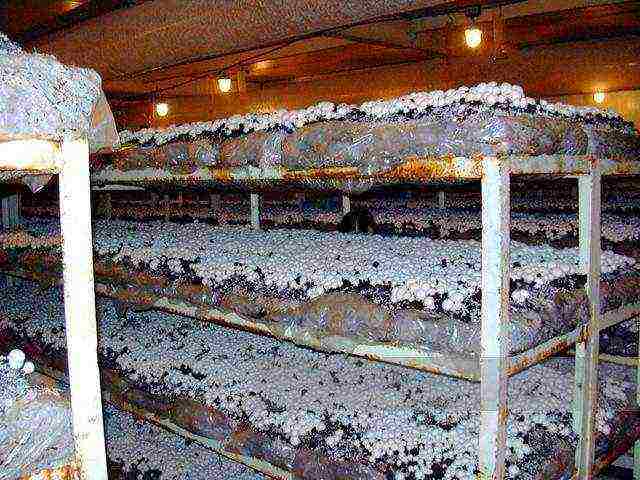
It will be very convenient to place wooden flooring or pallets in a basement or greenhouse, you can pour the soil directly onto the prepared surface, not forgetting to water the substrate from time to time.
If you are new to growing mushrooms, then the material in the form of myceliums is best purchased in a specialized store. Spore myceliums are sold in special containers, they are manure and grain. The dung mycelium is divided into equal pieces and placed in the substrate to a depth of about 5 centimeters; it is better to place them in a checkerboard pattern so that the distance between the seedlings does not exceed half a meter. In order to save space. Grain mushrooms are sown in a slightly different way, grains are laid out on the substrate layer, and then covered with a layer of soil about 5 centimeters. The optimum temperature for the development and growth of myceliums is considered to be +25 degrees, then after ten days, the temperature should be reduced to 20 degrees, and the surface of the substrate should be covered with an even layer of soil of 3 centimeters. After a week, the temperature is lowered to +16 degrees, after a month you can wait for the first mushrooms.
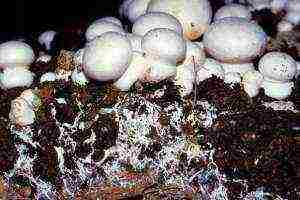
Growing honey agarics at home
An equally important mushroom variety, which is grown by mushroom pickers at home, is considered to be honey mushroom. Its unpretentiousness and simple care for mycelium makes honey mushrooms very popular mushrooms. The most common way to grow honey agaric is to breed it in wooden tubs. This cultivation method is common because it can be used both on a personal plot and on specially prepared forest lands. The main advantage in growing honey mushrooms is their low financial cost, as well as the ease of reproduction of myceliums. The cultivation of honey agarics in wooden tubs is carried out mainly by amateur mushroom pickers.

Practically any varieties of honey agarics are suitable for breeding honey mushrooms at home.Wooden decks, tubs, troughs made of deciduous wood can serve as a landing place. But conifers are not used in mushroom cultivation, as they can cause bitterness of the grown product, due to the high resin content. Growing honey mushrooms is a fairly simple procedure, and differs little from the cultivation of other myceliums. The very procedure for cultivating honey agaric consists in infecting a wood platform with mycelium or planting raw materials. It is necessary to make cuts in the thickness of wooden containers for planting or drill holes, and then fill the grooves with mycelium or planting material. After the procedure of filling with mycelium, the holes are covered with a prepared substrate. The most simplified option for growing honey agaric is filling the rotten stump with mycelium, by infecting the bark and crevices, and then sprinkling with rotted manure mixed with straw in proportions 1: 1.
Monitor the quality of your planting material, since it is difficult to acquire high-quality mycelium or mycelium. For home growing honey mushrooms, grain mycelium, which is purchased in specialized stores, is perfect. Pieces of spore-infested wood are also a fairly common option. Infected wood can be found in the forest itself and recognized by a white bloom, as well as a specific mushroom smell. Such myceliums are carefully removed with a knife or file, divided into pieces, and introduced into the prepared slots in the prepared stumps. Before removing forest mycelium, make sure the mushrooms are edible.
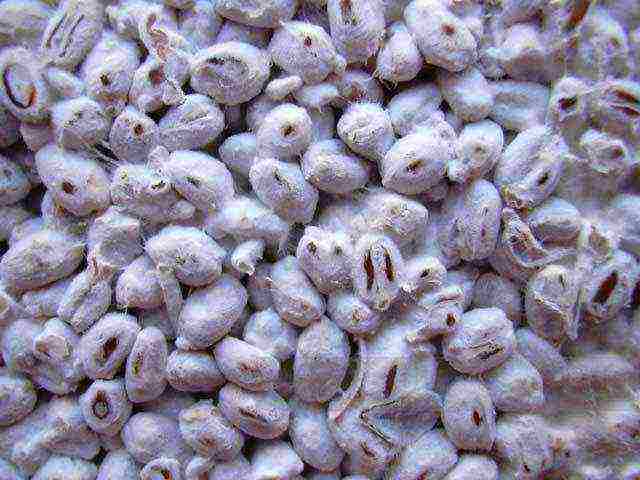
After the performed procedure with the introduction of mycelium, for the accelerated development of the mycelium, the mushroom plantation can be isolated with cellophane, and with proper care, the honey agaric harvest can be obtained by autumn. Climatic and other factors (such as the quality of mycelium, moisture and wood) directly affect the growth rate and development of honey agaric. The mushroom harvest will not immediately please you with its abundance. When growing mushrooms on your site, take into account the fact that myceliums and fungal spores can adversely affect the roots of trees, as well as wooden structures. Therefore, exclude the possibility of contamination of fruit trees with fungal spores. After the mycelium has been introduced into the soil, the fruiting of the mycelium will last about 6 years. Mushroom plantations are quite aggressive, so it is better to fence them off with grooves filled with sand so as not to harm the garden plants.
With the development of the popularity of mushroom farms, mushroom sticks began to be widely used. Special wooden sticks infected with fungal spores. The simplicity of working with such raw materials is good news, the sticks are simply inserted into the bark or holes, and then covered with wet sawdust or small straw. This method of growing mushrooms is suitable for a garden plot, but in industrial enterprises, only grain mycelium is used for growing mushrooms.
Growing oyster mushrooms at home
Another common mushroom with excellent taste is the oyster mushroom. There are quite a few ways to grow oyster mushrooms. This article will describe a method that is suitable for both hobbyists who grow mushrooms in small batches and for large-scale production. In the wild, oyster mushrooms grow on stumps and deciduous trees. The optimal temperature for the development of mycelium is +25 degrees. Then, at a temperature of + 14-16 degrees, fruiting begins, for up to 5 weeks. The sizes of oyster mushrooms range from 5 centimeters to 30, the color of the mushroom is gray, with a brown tint. Oyster mushroom is a rather aromatic mushroom with good taste. These mushrooms are also suitable for pickling and pickling, as well as frying and cooking soups.

So, the substrate for growing oyster mushrooms must be prepared in advance. A mixture of sawdust, small straw and sunflower husks will serve for him. The substrate must be clean, without the presence of foreign objects, it is better to boil the sawdust before preparing the soil to destroy the harmful microflora. After the substrate is dried on a film, spread out in a thin layer.
Temperature and humidity are important for growing mushrooms, so the room should be equipped with everything you need, clean and well ventilated. Oyster mushroom grows well in basements equipped with heating appliances, hoods and lighting.
You can start planting mycelium after all the necessary conditions are met for growing mushrooms, namely after preparing the substrate and premises. Oyster mushroom mycelium can be purchased at specialized factories and farms, as well as in gardening stores. You can start sowing after the substrate has been placed at the bottom of ordinary plastic bags or bags, then on a layer of 8 centimeters, the mycelium is laid out in 3 centimeters, broken into pieces, and covered with substrate on top and so on alternately to the top. The bag is tied, the contents are compacted, then incisions are made on the bag at a distance of 2-3 centimeters, for further growth of mushrooms and the removal of excess moisture.
The bags filled with mycelium are placed vertically, about half a meter apart, to allow the oyster mushrooms to grow. It will be easier if the bags are formed in such a way that the location of your mushroom "bed" does not bring you any inconvenience later. You must move freely between bags for ease of watering and harvesting. You can arrange the bags in tiers if the room is high enough, which will increase the cultivation area. The optimal room temperature is 19-25 degrees, when the mycelium begins to develop, the contents of the bags will turn white, as the spores will penetrate deeper into the substrate. Watering bags with mycelium is done once a day. If you follow all the requirements for the cultivation of myceliums, then after three weeks, your mushroom garden will delight you with the first fruits.

In order for the fruiting of mushrooms to develop actively, some mushroom gardeners resort to tricks. To do this, the substrate sprouted with mycelium is stimulated with a low temperature from +3 to +6 degrees, this temperature is maintained for about two or three days, then you need to leave the substrate in bags, making wide enough holes there, or remove the substrate and leave it without bags and do not water for a week. After a week of lack of moisture, the substrate is watered abundantly, with water at room temperature, and then once a day, air the room, with myceliums, the air temperature in the room should be +15 degrees.
For the first week, your myceliums do not need lighting, but then it is necessary to organize sufficient bright artificial lighting over the bags with mycelium. After the mycelium begins to bear fruit, a new crop of mushrooms can be obtained every three weeks, however, over time, productivity will decrease, which will serve as a signal to replace the substrate and introduce a new batch of mycelium, that is, to resume the cycle. For every 100 kilograms of substrate, experienced mushroom pickers get about 50 kilograms of fresh mushrooms. It is very important, before starting a new fruiting cycle of myceliums, the room should be disinfected in order to get rid of the pathogenic environment of the predecessors. The approximate number of cycles per year will be 4-7, depending on the care and growing conditions.
Cultivation of porcini mushrooms in a personal plot
Cultivation of porcini mushrooms, in personal plots, the procedure is not painstaking and quite simple. Therefore, it is becoming increasingly popular.If you do not want to spend money on the purchase of mycelium, then you can do without it, you just need to find the mycelium and the place where the porcini mushrooms grow. You can collect mature mushrooms and prepare a mixture with white mushroom spores with your own hands. For this, mature porcini mushrooms are crushed and poured with clean water, left in a dark place for a day. Thus, you get a solution containing numerous white fungus spores. Next, you need to act according to the scheme, choose a place that is darkened, it is better under deciduous trees and organize something like a garden bed. To do this, we fertilize the ground with rotted manure, mixed with chopped straw or sawdust, mix everything thoroughly with the soil, level and water the prepared soil with the prepared mixture. It should be borne in mind that porcini mushrooms enter symbiosis only with deciduous trees, and do not like the scorching sun.
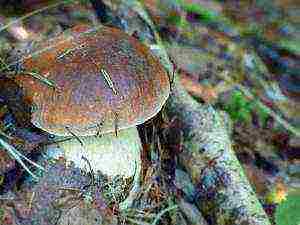
Another way to grow porcini mushrooms is to remove the mycelium from the old place and move it to your personal plot. The main thing is to properly organize the place for planting mycelium. Pay attention to the trees under which the mycelium grew in the forest or glade, to the structure of the soil, this will help to establish fruiting in the future on your site. So, after removing the mycelium, collect enough soil from this place so that it would be enough to add it to the soil on the site after the mycelium was laid. We loosen the earth, fertilize it with manure, pour out the brought soil, loosen it again. Then we make depressions in the prepared soil and lay out the pieces of mycelium, sprinkling on top with a mixture of sawdust, straw, sunflower husks or forest soil, then slightly moisten. The mushrooms should not be filled with water, and the soil should not be allowed to dry out, that is, the place where the porcini mushrooms grow must be constantly moistened.
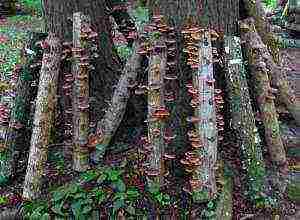
Mature parts of porcini mushrooms can also be used as seeds. Porcini mushrooms must be crushed, loosened the soil, fertilized with compost and chopped hardwood sawdust. Planting is done, as in the previous version, only the chopped mushroom is introduced. Then the soil is moistened and sprinkled with chopped straw on top. Both fresh mushrooms and slightly dried mushrooms are suitable, such mushrooms are laid out in a dense layer on the prepared soil and watered every day, after the soil is infected with spores, the mushrooms can be removed. With proper selection of the site for planting porcini mushrooms and adherence to fertilization and planting technologies, the harvest will appear next year. Reproduction will take place incrementally, from several mushrooms to whole mushroom families, and in another year from your mushroom plantation you can get about two kilograms of porcini mushrooms.
These methods of cultivation and cultivation of porcini mushrooms are suitable only for amateur mushroom growers. The described cultivation methods are widely used in the area where the necessary mushrooms grow in sufficient quantities. Industrial production of porcini mushroom is established to a greater extent in Poland. But our domestic producer does not stand aside, increasing the volume of mushroom production.
Unfortunately, in our time, mushroom growing technologies lag behind world producers, although earlier in Russia mushrooms were grown on an industrial scale. Today mushroom cultivation is rather an amateur activity, undoubtedly profitable. The price coefficient on supermarket shelves is quite high, but mushroom cultivation on an industrial scale is not yet practiced at the proper level in our country, preferring to import foreign mushrooms.
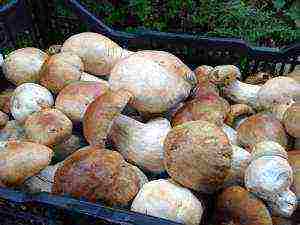
If you want to grow porcini mushrooms, it is worth considering the fact that their mycelium differs from other varieties in that it grows together with the roots of trees, forming a kind of symbiotic relationship, and without it, the development of mycelium is not possible.Therefore, the cultivation of porcini mushrooms should take place near the trees growing on your site. Better yet, organize your mushroom farm in the adjacent forest belt.
Growing chanterelles at home
Cultivation of chanterelles, like other mushrooms, is based on the basic rules of mushroom cultivation. Planting a mushroom next to a tree is carried out with the help of a spore infusion, pieces of mycelium or seed material, with the assistance of a layer of forest soil. The composition of the forest soil is saturated and nutritious, and the upper humus layer is responsible for the development of the mycelium. The bulk of the soil is rich in trace elements and organic compounds, it also contains spores of fungi, from which fruits then grow. Therefore, when growing chanterelles on your site and preparing mycelium for planting, choose a place where their main population is concentrated, cut off the mushrooms, and carefully remove the mycelium and transfer it to your site together with the soil.
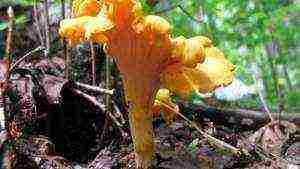
The removal of forest soil should be carried out near trees; the beginning of autumn, or early spring is considered the optimal harvesting time. Layers of soil are dug, at least 20 centimeters thick. At the site for contamination of the soil with chanterelles, the lower layer of forest soil is used. The organization of a mini-mushroom farm should take place in a cool, shaded place, among the trees. We bury the mycelium in the ground and sprinkle with chopped straw. Maintain the required humidity.
If you previously noticed a place where there are a lot of chanterelles, take note of this place. However, the absence of mushrooms cannot guarantee that the mycelium is dead, it is just possible that the season was less fruitful, the main criterion should be that the mushrooms were seen earlier in this place. Spores of fungi in the soil layer remain for a long time and they are not afraid of bad weather and oppression of fruiting. They continue their existence remarkably, using a minimum of nutrients, taking advantage of their protection.
In order for the forest soil to serve as a good soil for a future mushroom farm, it must go through a certain stage of preliminary preparation. This preparation method will improve the quality of forest soil. To properly prepare the forest soil, it is packed in plastic bags and dried in a cold room, the main thing is to leave oxygen to the soil. The soil can be stored in such conditions for up to a year, and without harming the spores of fungi, but pathogenic microorganisms will die without moisture. As a result of this kind of training, mushroom spores will become accustomed to drought conditions and become more resilient.

It is better to plant chanterelles on the site in early spring, high humidity and warm weather will contribute to better implantation of the mycelium into the ground and its further development. The previously harvested forest soil must be mixed with garden soil in a 1: 1 ratio, pour the mixture from the soil into the prepared grooves, add mycelium or a prepared solution of chanterelles there, and cover it with fine straw or matted foliage on top to protect the mushroom bed from drying out. Watering must be organized in such a way as not to harm the mycelium, it is better to water in small portions slightly moistening the soil, because water stagnation should not be allowed. The mycelium can simply die from an excess of moisture, as a result of decay.
Chanterelle, has not yet received its distribution, although it has an excellent taste and contains quite a few useful substances. Only a few mushroom growers grow chanterelles in their plots. However, it is quite possible that soon chanterelles will establish themselves and the industrial production of mushrooms will turn its gaze on these mushrooms. And we can all be content with tasty and healthy mushrooms that can heal even gastrointestinal diseases.
Growing shiitake mushrooms at home
Unpretentious, easy to grow and very useful shiitake mushroom, is very popular in foreign countries. Foreign industrial companies grow this mushroom in huge quantities. And for good reason. In terms of useful properties, the mushroom is not inferior to its relatives, it strengthens the nervous system, has a tonic effect. It contains the optimal amount of amino acids for humans.
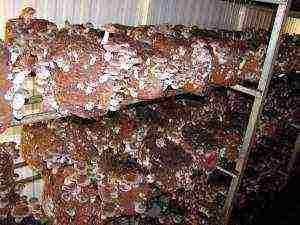
Shiitake mushrooms are traditionally grown on tree hemp and logs. In the countries of the rising sun, this mushroom is very popular. In our country, the shiitake mushroom is grown on sawdust of deciduous trees. The largest yields can be obtained if these mushrooms are grown on an enriched specially prepared substrate, which is formed into blocks and becomes infected with myceliums.
The main constituent of the substrate for cultivating shiitake is beech, birch, oak, ash sawdust, enriched with special fertilizers. Coniferous sawdust is not suitable for cultivation. The content of esters and resin substances in them will have a disinfecting effect, and only hinder the development of mycelium. The size of the sawdust also plays an important role in mushroom cultivation. Since those that are too small will become lumpy and disrupt aeration, slowing down the growth of the mycelium. Sawdust can be mixed with wood chips for better gas exchange. In order for the shiitake mushrooms to please you with the harvest, the soil must be sterilized before settling the mycelium. The fact is that the shiitake mycelium, like all other mushrooms, develops more slowly than pathogenic microorganisms, which can harm the mycelium in the future and leave you without a mushroom harvest.
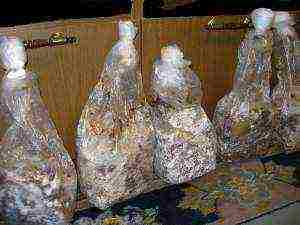
The substrate infected with mycelium should not be too wet and dense, in such a soil a bacterial infection develops. The substrate for industrial production of shiitake is stored in bags, then sterilized and used for its intended purpose. However, there are other methods of preparing the substrate with your own hands. It is not difficult to prepare the substrate, the sawdust is sterilized by heat treatment, cooled, dried, then sown with mycelium, and then packaged in plastic bags. Thus, the mycelium develops in a warm temperature, the mycelium grows for a month and a half, and after the contents of the bags are taken out and mushroom beds are formed already in the basement or other room intended for growing mushrooms.
The entire process of packing and contamination of the soil with mycelium must be carried out in compliance with sanitary standards. Fruiting on open formed blocks lasts about six months.
The cultivation time for shiitake mushrooms in compliance with the thermal treatment of the soil, whether it be sawdust or other substrates intended for this purpose, has a shorter period than real street cultivation. This method of growing mushrooms is called intensive, harvesting, subject to all the requirements of this method, takes place year-round, in specially designated places indoors. To increase the development time of the mycelium, special fertilizers and enriching additives are introduced into the soil. Sources can be elements of organic origin and nitrogen-containing. You can freely purchase ready-made supplements for growing mycelium and increasing the fruiting of shiitake in specialized stores, or you can use compost or rotted manure. In order to increase the level of acidity, as well as for the purpose of enrichment, in addition to organic matter, a dose of mineral fertilizers is also introduced into the substrate, in the form of crushed chalk, bone meal, gypsum or ready-made ones purchased in a store.

And in conclusion
Any varieties of mushrooms are suitable for home cultivation.With proper care and adherence to all the rules for growing mushrooms, even on your personal plot, you can organize a fruit-bearing mushroom farm, inferior to an industrial one only in terms of production, but undoubtedly winning in terms of the safe characteristics of the product obtained. Growing mushrooms can also be an excellent business for your family, at a minimum cost, you will get maximum profit and provide yourself with the freshest mushrooms all year round.
